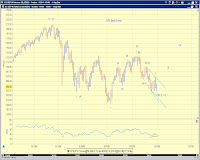The Bond Mania Since long term Treasury yields had topped in 1981, bond yields have been in a secular decline over the next 30 years.
Despite the recent rally fueled by QE2-lite and QE2 front-running, the secular bull market in bonds very likely has already ended in late 2008.
If this is the case, the 2010 bond rally represents the first major cyclical correction in a new secular bear market for bonds. The initial stage of this new secular bear market could be driven by either reflation or a bursting of the bond bubble.
I’ll explore the secular rally and the budding bear market in bonds from a EWP perspective below. There are plenty of the insightful discussions involving economic fundamentals, policy and bond market technicals in the public domain.
A Long Term PerspectiveChart 1 presents three credible wave structures in the 30-year bond price, all of which point to an end to the bond mania in late 2008. There are two ways to count the secular bull market in bonds as being corrective and one way to count it as a completed impulse wave.
 [Black- a large generic corrective wave]
[Black- a large generic corrective wave] If one simply counts the number of higher highs and higher lows since the 1981 low in bond prices, one would arrive at 11 waves without having to bother with the exact labeling of this structure. Conveniently, 11 waves represent a corrective structure according to EWP. I have identified the structure for each segment of these 11 waves in
Chart 1.
[Blue- a triple three ending with a diagonal triangle] The labeling for this count in
Chart 1 is self-explanatory. Note the alternation between the two [X] waves, the first one being a flat and the other one being a zigzag. The implication of an ending diagonal is a sharp sell-off to the base of the ED, around $75 in this case. So expect bond prices to be cut in half if this is the case.
[Green- a completed impulse wave, ending with a diagonal triangle] The labeling for this count in
Chart 1 is self-explanatory. Note the alternation between wave (2) and wave (4), with wave (2) being a zigzag and wave (4) being a triangle. Under this count, wave (5) is the ending diagonal, which implies a sharp sell-off to the base of the ED, around $75 in this case. So expect bond prices to be cut in half if this is the case as well.
Near Term Outlook – close to a turnI’ll focus on the 10Y note yield regarding near term outlook, despite the fact that it belongs to the most “structurally manipulated” area by the N-th QE. The choice is a challenging one but relevant at the same time.

On the 10Y note yield,
Chart 2 shows that the sell-off between late 2008 and Q2/2010 is a decent five-wave structure, and the subsequent rally is best counted as a zigzag (A)-(B)-(C) correction.
The market is likely approaching the end of this correction – note that (C)=(A) at about 2.5% for the 10Y and the next potential turn date is within two weeks. Chart 3 and
Chart 4 zoom in on the daily and hourly wave structures to support the notion that an end to the rally is in sight.
If wave [5] of 5 of (C) does not extend (which is a lower likelihood scenario), the bottom in yield is already in. 

 [453PM] SPX cash index squiggles -
[453PM] SPX cash index squiggles - [1] Chart 1 presents the top counts. Today's low is
[1] Chart 1 presents the top counts. Today's low is

 [3] Cycles points to a potential turning point this week (Chart 4). Since the market has been selling off into this week, the next turn if it comes true would be an uptrend.
[3] Cycles points to a potential turning point this week (Chart 4). Since the market has been selling off into this week, the next turn if it comes true would be an uptrend.















































